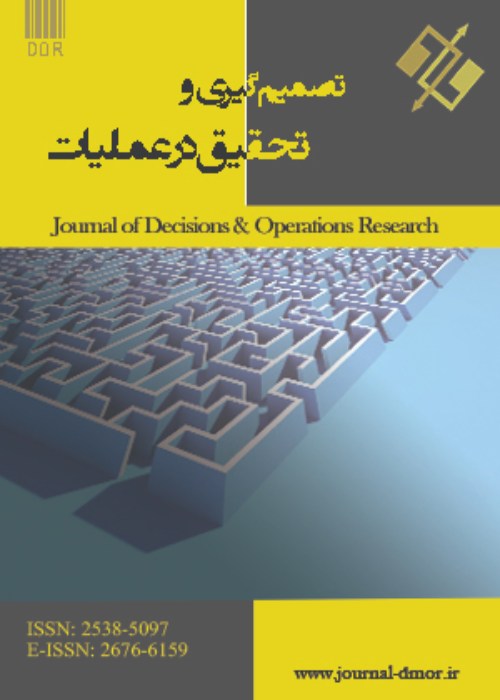فهرست مطالب

نشریه تصمیم گیری و تحقیق در عملیات
سال دوم شماره 3 (زمستان 1396)
- تاریخ انتشار: 1397/01/07
- تعداد عناوین: 5
-
- مقاله پژوهشی
-
صفحات 179-194یکی از مواردی که تاثیر بسزایی بر مدل سازی و حل مسائل دنیای واقعی دارد، شرایط عدم قطعیت روی پارامترها می باشد. با توجه به اینکه بسیاری از پارامتر ها در دنیای واقعی معمولا مبهم و نادقیق هستند، در این مقاله، مساله حمل ونقل سه بعدی که در آن، هزینه های حمل و نقل و تقاضا ها غیر قطعی و از نوع متغیر های فازی نوع-2 هستند، موردبررسی قرار می گیرد. بر اساس نظریه امکان فازی و تعریف اندازه اعتبار، تابع هدف مساله را با استفاده از ارزش در معرض ریسک هزینه های کل تشکیل داده و نیازمندی های مشتریان را با عنوان محدودیت های اعتبار مدل سازی می شود. همچنین متغیر های فازی نوع-2 را با روش کاهش مقادیر بحرانی امکانی به مقادیر قطعی تبدیل کرده تا مدل اصلی به دو زیر مدل برنامه ریزی پارامتری عدد صحیح مختلط تبدیل شود که می توان آن ها را با روش برنامه ریزی پارامتری حل کرد. به منظور نشان دادن کارایی روش حل پیشنهادی، یک مثال عددی حل شده است. نتایج عددی نشان می دهند که روش بهینه سازی پارامتری می تواند روش انعطاف پذیرو کارآمدتری برای تصمیم گیرندگان برای مدل سازی شبکه حمل ونقل سه بعدی با هزینه ثابت باشد.کلیدواژگان: مساله حمل ونقل سه بعدی با هزینه ثابت، متغیر های فازی نوع-2، روش کاهش مقادیر بحرانی امکانی، اندازه اعتبار و برنامه ریزی پارامتری
-
صفحات 195-204در این مقاله، برآورد بیزی و بیز تجربی پارامتر شدت ترافیک در مدل صف تحت توابع زیان متقارن و نامتقارن و بر اساس دو پیشین مختلف ناآگاهی بخش و بتا موردبررسی قرار می گیرد. برآورد پارامترهای این مدل بهروش های بیزی، درستنمایی ماکسیمم، گشتاوری ارائه می شود. خواص و کاربردهای این دو برآوردگر در نتایج عددی موردبحث قرارگرفته است.کلیدواژگان: برآورد درستنمایی، برآورد گشتاوری، برآورد بیزی، بیز تجربی
-
صفحات 205-212همزمان با توسعه جغرافیایی سیستم های گرید، ناهمگن بودن و پویایی منابع این سیستم ها افزایش می یابد. یکی از چالش های مهم، انطباق سرویس های کشف منبع با محیط های توزیع شده، مقیاس پذیر و پویا جهت افزایش کارایی سیستم های گرید می باشد. در این مقاله، به مکانیسم های کشف منبع غیرمتمرکز مبتنی بر شبکه های نقطه به نقطه می پردازیم و روش های کشف منبع را به دو گروه مدل های غیر ساختاری و مدل گره عالی دسته بندی می نماییم. ما به بررسی نمونه هایی از هر دسته بندی می پردازیم و آن ها را ازلحاظ کارایی، مقیاس پذیری و پویایی موردبحث قرار می دهیم.کلیدواژگان: گريد، نقطه به نقطه، سرويس هاي کشف منبع، گره عالي
-
صفحات 213-227رویکرد جدیدی که در سال های اخیر بر مدیریت عملیات حاکم شده، رویکرد مدیریت زنجیره تامین(SCM) است. مدیریت زنجیره تامین در سال های گذشته توجه زیادی از محققان را به خود جلب کرده است. این روش برای بهبود همزمان عملکرد اقتصادی، اجتماعی و محیطی تبدیل شده است. بنابراین، ارزیابی SCM یک وظیفه مهم برای هر نوع از سازمان ها است. در میان روش های ارزیابی، تحلیل پوششی داده ها(DEA) یک روش مناسب برای ارزیابی SCM به نظر می رسد. برخی از واحدهای تصمیم گیرنده از چندین بخش یا مرحله تشکیل شده اند که یک شبکه از زیرفرآیندها را ایجاد می کنند. برای ارزیابی این نوع از واحدها از روش های تحلیل پوششی داده های شبکه ای استفاده می شود. در این مقاله، دو رویکرد برای محاسبه کارایی مدیریت زنجیره تامین به صورت فرآیند شبکه ای در نظر گرفته شده است. در رویکرد نخست، تعمیم مدل مجموع وزن دار برای محاسبه کارایی و بازده به مقیاس زنجیره تامین با فرآیند دومرحله ای را به صورت تک هدفه در نظر گرفته ایم. در رویکرد دوم، مدل مجموع وزن دار را برای اولین بار برای محاسبه کارایی و بازده به مقیاس زنجیره تامین با فرآیند دومرحله ای را به صورت یک مدل برنامه ریزی چندهدفه ارائه کرده ایم؛ لذا با توجه به نظر و علایق تصمیم گیرنده سعی در تک هدفه کردن آن داشته و کارایی مراحل و فرآیند تولید کل را پس از تک هدفه کردن به دست آورده ایم. در قسمت دیگر مقاله، با توجه به دو رویکرد ارائه شده، درصدد تعیین بازده به مقیاس مدیریت زنجیره تامین آمده ایم. روش های پیشنهادی، برای ارزیابی کارایی و بازده به مقیاس زنجیره تامین در شرکت های تولید رزین ایران استفاده شده است. سه شرکت در هر دو رویکرد، کارای شبکه ای بوده و دارای بازده به مقیاس های افزایشی، ثابت و کاهشی هستند.کلیدواژگان: مدیریت زنجیره تامین، تحلیل پوششی داده شبکه ای، کارایی، بازده به مقیاس، شرکتهای تولید رزین
-
صفحات 228-235در این مقاله تعیین ناحیه ی جواب مدل های برنامه ریزی خطی بازه ای (ILP)که در حالت کلی یک مسئله ی NP سخت است، در نظر گرفته شده است. در تمامی روش های حل مدل های ILP تنها شرط شدنی بودن (یعنی جلوگیری از نقض قیود) مدنظر قرارگرفته است. روش حالات بهترین - بدترین (BWC) یکی از روش های حل مدل ILP هست. گرچه این روش بهترین و بدترین مقادیر تابع هدف را تعیین می کند اما برخی از جواب های حاصل، نشدنی می باشند. برای تضمین شدنی بودن جواب ها روش دو گامی بهبودیافته (ITSM)، روش برنامه ریزی خطی اصلاح شده (MILP) پیشنهادشده است. هرچند در این روش ها، تمام جواب ها شدنی اند اما برخی از آن ها بهینه نمی باشند. با استفاده از یک رویکرد جدید، ناحیه جوابی برای حل مدل ILP معرفی می شود که با استفاده از دو آزمون، شدنی بودن و بهینگی فضای حاصل تضمین می گردد.کلیدواژگان: برنامه ریزی خطی بازه ای، روش BWC، روش ITSM، روش MILP، عدم قطعیت
-
Pages 179-194Uncertainty is one of the most important factors which affect transportation models. As the value of most of the parameters in real-word problems are not clear, this paper represent a cost-based transportation problem with type-2 fuzzy parameters. Applying possibility theory, the fuzzy objective function and fuzzy constraints are formulated by a credibility measure. In addition, type-2 fuzzy variables are crisped using possibillistic critical value reduction method, in order to convert the main model into two mixed-integer sub-models which are solvable by a parametric programming approach. A numerical example including crisp demand and cost values but fixed and variable probability distributions is solved by the proposed approach. The results prove the effectiveness and flexibility of the proposed approach.Keywords: Fixed-charge solid transportation problem, Type-2 fuzzy variable, Possibillistic critical value reduction method, Credibility measure, Parametric programming
-
Pages 195-204Armero and Bayarri get Bayesian estimation from traffic intensity in M/M/1 model in 1994. Sharma and Kumar get Bayesian and classical estimations of different parameters of M/M/1 model under loss function in 1999. Furthermore, use of classical methods to estimate unknown parameters of previous distribution is suggested by Mises for the first time in 1943. In this paper, Bayesian estimation and empirical Bayes of traffic intensity parameter are assessed in the M/M/1 queuing model. Estimation of the parameters of this model is presented by methods of Bayes, likelihood, and moment. The characteristics and applications of both estimators are discussed in numerical results. The quadratic theory has many uses in communication theory, computer design, etc. The statistical deduction in quadratic process and quadrant process estimation, such as rate of entry, service rates and traffic jams, has attracted researchers in the past few years. Suppose that the M / M / 1 queue system with an average log rate λ, as well as an average service rate of 1 / μKeywords: likelihood estimation, moment estimation, Bayes estimation, empirical Bayes
-
Pages 205-212While the Grid systems are distributing geographically, the heterogeneity and dynamic features of their resources are increasing. One of the important issues in this systems is adaptation the discovery services with more scalable and dynamic environments to improve the discovery performance. In this paper, we concentrate on the Decentralized mechanisms based on the Peer-to-Peer (P2P) networks and classify the discovery approaches into two main categories: the Unstructured and Super-Peer models. We review the major development of these categories and provide discussion about the efficiency, scalability, and dynamic terms.Keywords: Grid, Peer-to-Peer, Discovery Service, Super-Peer
-
Pages 213-227In recent years, a new approach which has been dominant over operation management is the supply chain management approach. Supply chain management has attracted most researcher's attentions in recent years. This is the way to improve the economic, social and environmental performance. Therefore, the evaluation of SSCM is an important task for all types of organizations. Among the methods of evaluation SSCM, it seems that data envelopment analysis (DEA) is an appropriate approach. Some of decision-making units composed of several sections or stages that make a network of sub-processes. In order to evaluate such units, data envelopment analysis (DEA) is applied. This paper presents two approaches to calculate supply chain management as a network process. In the first approach, we consider the generalization of weighted sum model to calculate efficiency and returns to scale (RTS) of supply chain with two-stage process as single-objective approach. In the second one, we introduce the weighted sum model to calculate efficiency and returns to scale (RTS) of supply chain with two-stage process as multi-minded approach, so we try to make it to be single-objective approach and then calculate the efficiency of its total production process, according to the decision-maker's ideas and interests. In the next section of this paper according to the two above approaches, we determine the percent of returns to scale (RTS) of supply chain. Suggested ideas are used to evaluate the efficiency and returns to scale (RTS) of supply chain in resin production companies.Keywords: Supply chain management, Network DEA, efficiency, Return to Scale, Resin production companies
-
Pages 228-235In this paper, solution space of interval linear programming (ILP) models that is a NP-hard problem, has been considered. In all of the solving methods of the ILP, feasibility condition has been only considered. Best-worst case (BWC) is one of the methods for solving the ILP models. Some of the solutions obtained by the BWC may result in an infeasible space. To guarantee that solution is completely feasible, improved two-step method (ITSM) is proposed. By using a new approach, we introduce a space for solving ILP models in which by two tests, feasibility and optimality of the obtained space has been guaranteed.Keywords: Interval linear programming, BWC, ITSM, MILP, Uncertainty


